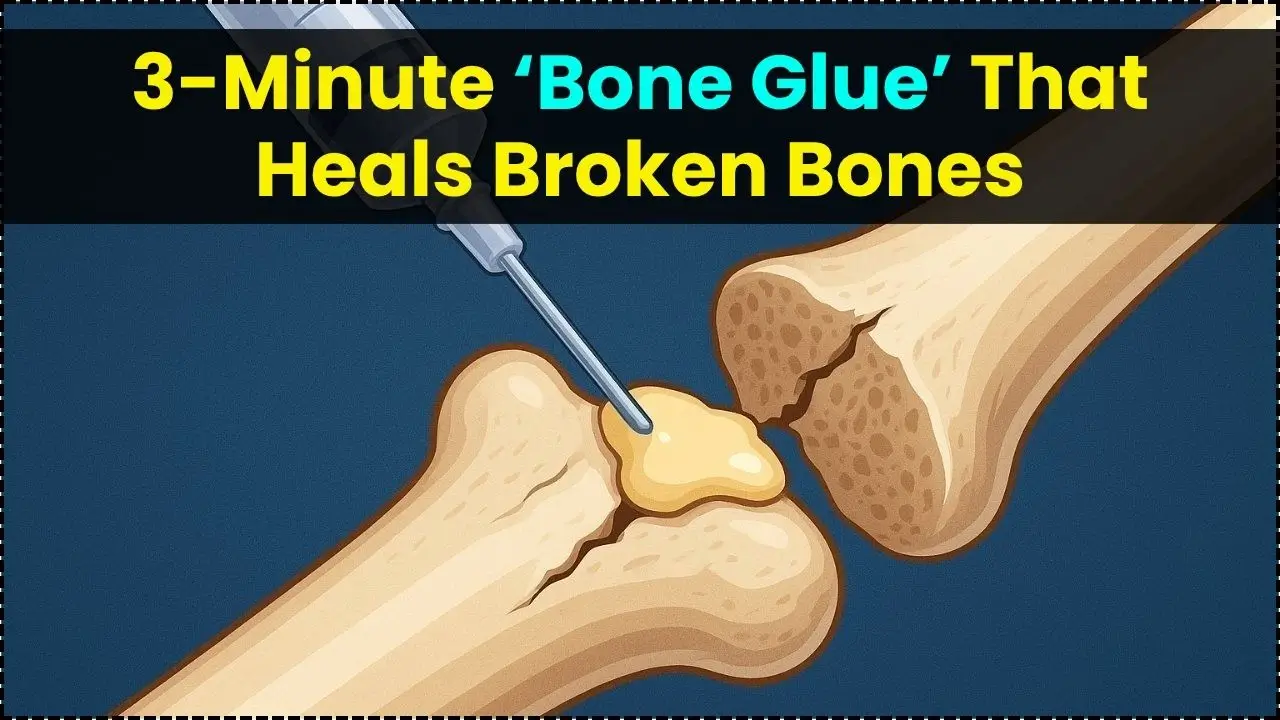If the phrase bone glue sounds like science fiction, here’s the twist it’s real, and it’s poised to change how fractures are fixed in operating rooms worldwide. The innovation centers on an injectable, bioabsorbable adhesive known as Bone‑02 that can bond broken bone fragments in about three minutes, potentially reducing reliance on metal screws and plates in well‑selected cases. For patients, that could mean smaller incisions, shorter surgeries, and fewer second procedures to remove hardware.

This oyster‑inspired bone glue offers rapid fixation in wet, blood‑rich surgical fields where most adhesives fail, then gradually dissolves as new bone forms. Early clinical use reports highlight strong bonding metrics and successful minimally invasive procedures, while experts caution that broader peer‑reviewed trials are essential to define exactly which fractures it can safely replace hardware for.
Table of Contents
Goodbye to Screws and Plates
| Key Detail | Summary |
|---|---|
| Product | Bone‑02 bone glue, inspired by oyster adhesion in wet environments |
| Core Claim | Bonds bone fragments in about 2–3 minutes |
| Application | Injectable; works in blood‑rich fields via small incisions |
| Bioabsorption | Dissolves as bone heals; aims to avoid removal surgery |
| Strength | High bonding force; lab‑reported shear and compressive strength in clinical ranges |
| Reported Use | Early clinical cases cited publicly |
| Status | Awaiting broad peer‑reviewed validation and wider approvals |
Bone glue is poised to shift fracture care from metal-first to biology-first, offering rapid fixation in minutes, smaller incisions, and the promise of fewer second surgeries when cases are well selected. The most credible near-term path is targeted adoption small bones, lower-load fractures, and minimally invasive workflows while high‑stress injuries will likely still need plates, screws, or nails until robust, peer‑reviewed trials prove adhesive‑only fixation can match outcomes. For patients and clinicians, the upside is compelling: faster procedures, less foreign hardware, and a recovery aligned with natural healing. The smart next step is rigorous multicenter evidence to lock in indications, safety, and long‑term performance setting the stage for bone glue to complement, and sometimes replace, traditional hardware where it truly makes care better.
Bone Glue Inspired By Oysters
Surgeons have long sought an adhesive that works where bones actually break inside a wet, bleeding field. By mimicking how oysters cling to turbulent, wet surfaces, Bone‑02 aims to create a durable bond quickly. That wet‑bonding chemistry is the differentiator: it enables stable fragment fixation during the crucial early window of healing without defaulting to large implants in every case.
How The Glue Works
After the fracture is reduced, surgeons inject the adhesive at the site. It sets in roughly two to three minutes, providing immediate stability that can tolerate early mechanical demands. Over time, the material biodegrades and is resorbed, ideally leaving behind healed bone and avoiding a second operation to remove plates or screws in suitable indications.
Trials Inspired Confidence In Results
Public reports describe successful use in numerous patients, including minimally invasive wrist fracture repairs performed through small incisions with a single injection. Case‑level follow‑ups at around three months have shown uncomplicated healing in examples shared to date. Even so, multicenter, randomized, peer‑reviewed trials remain the gold standard for defining indications, contraindications, and long‑term outcomes.
Potential To Replace Metal Implants?
Yes, selectively. Bone glue looks most promising for small bones, minimally displaced fractures, and patterns where cyclic load is modest. In high‑load long bones, unstable or comminuted fractures, and weight‑bearing sites under significant stress, adhesives may complement rather than fully replace plates, screws, or nails until strong comparative evidence proves otherwise. Expect a stepwise path where adhesives reduce hardware in targeted scenarios first.
Clinical Cautions From Surgeons
Orthopedic specialists welcome the concept but want clear protocols, peer‑reviewed data, and long‑term follow‑up before widespread adoption. Key questions center on infection risk, immune response, degradation timelines, and whether adhesive‑only fixation can safely support early function across ages and bone qualities, including osteoporotic bone. Robust evidence will determine who benefits most and when adjunctive support is still needed.
What It Means For Patients
For eligible fractures, bone glue could mean smaller incisions, shorter operating times, and fewer second surgeries. Reduced foreign‑body burden may lower certain complications tied to permanent metal hardware. Faster intraoperative fixation can also streamline anesthesia time and potentially accelerate early rehab—provided the fracture pattern and patient profile fit the indication.
Use Cases That Look Most Promising
- Wrist and hand fractures where precise fragment apposition and lower loads suit adhesive fixation.
- Elderly or medically complex patients who benefit from minimally invasive approaches and shorter surgical time.
- Fracture scenarios where hardware irritation and later removal are common, making a resorbable option attractive.
How It Compares With Current Advances
Bone‑02 aligns with a broader shift toward biodegradable, osteoconductive materials that support healing and then disappear. From bioactive implants to polymer‑mineral composites and handheld “glue gun” delivery concepts, the trend favors less invasive, biology‑friendly solutions that reduce the need for permanent foreign materials while preserving stability.
A Realistic Adoption Timeline
Breakthroughs rarely go mainstream overnight. Even with compelling demonstrations, expect a multi‑year journey of trials, regulatory reviews, and surgeon training. Early clinical use typically clusters around indications with the most favorable risk‑benefit profile. Over time, as evidence matures, indications expand or narrow to reflect what works best in real‑world practice.
If you’re a patient considering options, ask your surgeon whether bioadhesive fixation is appropriate for your fracture type, whether minimally invasive approaches are feasible, and if your hospital participates in relevant trials. Until peer‑reviewed data are published across centers, decisions should weigh the proven outcomes of standard fixation against the potential benefits of novel adhesives in the specific context of your injury.
FAQs on Goodbye to Screws and Plates
How fast does bone glue work during surgery?
The setting window described publicly is about two to three minutes after injection, allowing surgeons to achieve rapid stabilization once the fracture is reduced.
Will bone glue replace screws and plates completely?
Not across the board. Adhesives are likely to replace or reduce hardware in select fracture types with lower loads, while high‑stress fractures still rely on mechanical constructs unless rigorous comparative trials show otherwise.
Is Bone‑02 approved internationally?
Current public information centers on demonstrations and early clinical use; widespread regulatory approvals typically require comprehensive, peer‑reviewed trials. Availability will vary by country and health system until larger datasets are published.
What strength metrics matter for bone glue?
Clinicians look at shear and compressive strength, bond durability in wet conditions, and how those values translate into early functional stability. Just as important are biocompatibility, degradation profile, and clinical outcomes across different bones and patient populations.











